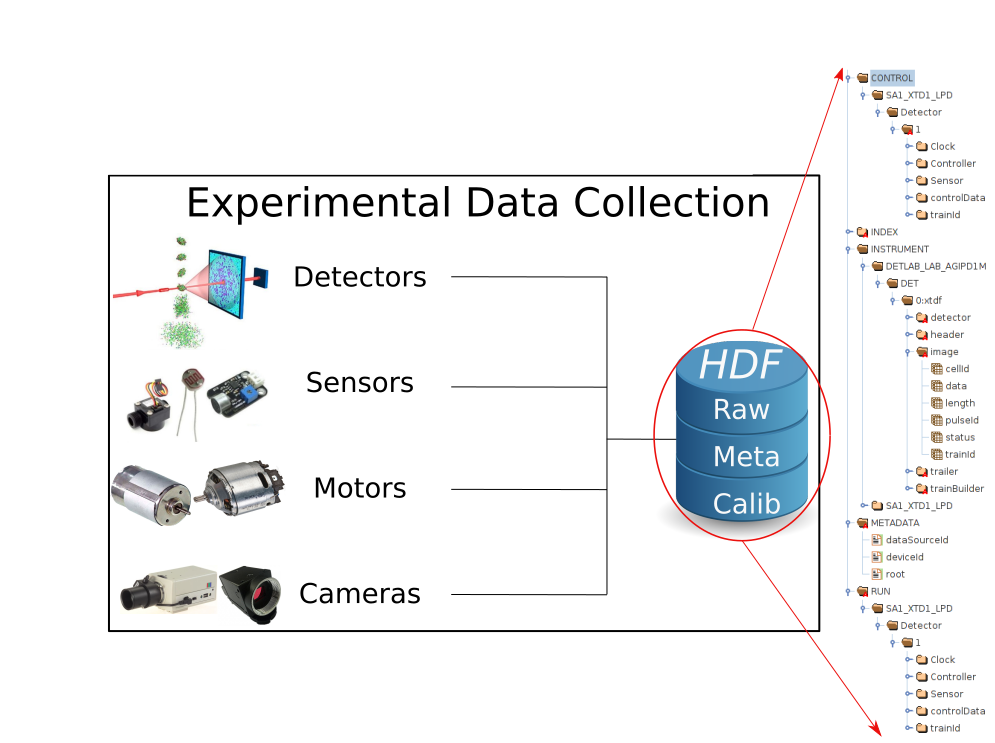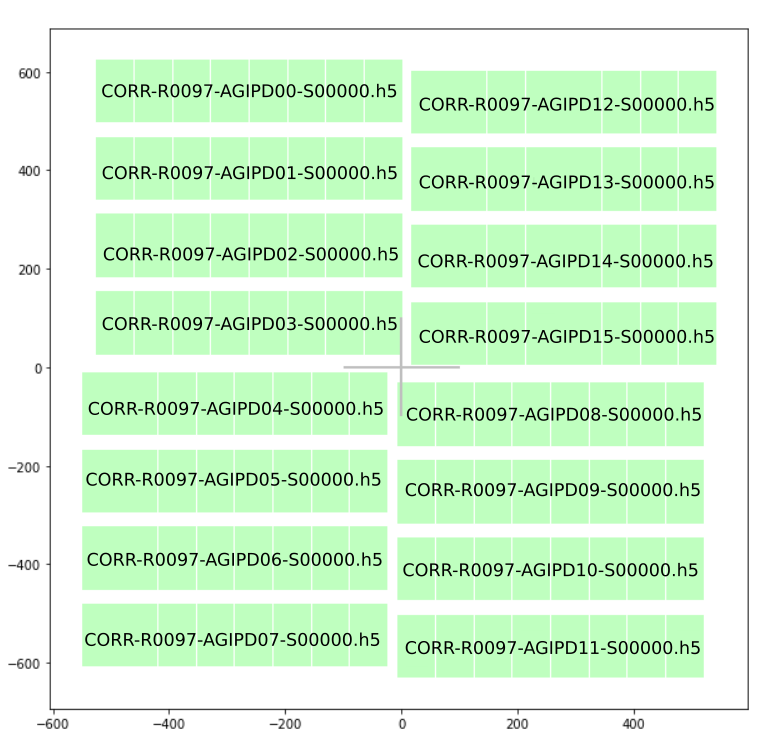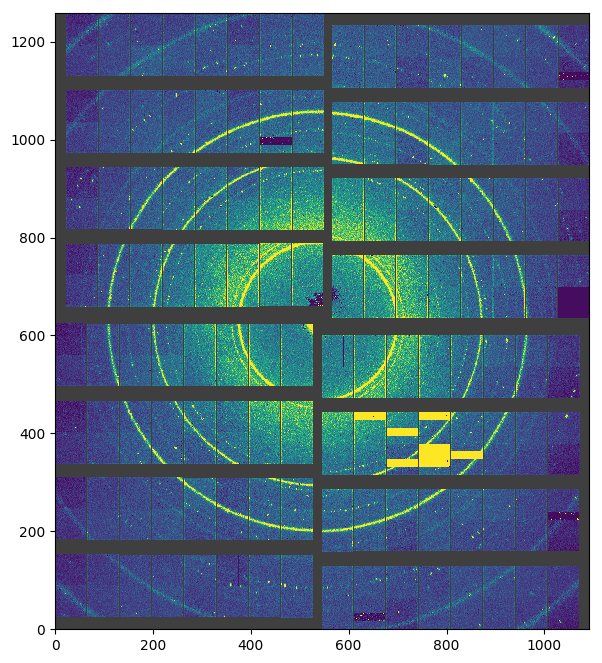

A Closer Look at Detector Data:

$: lsxfel /gpfs/exfel/exp/XMPL/201750/p700000/raw/r0273
r0273 : Run directory
# of trains: 156
Duration: 0:00:15.500000
First train ID: 198425241
Last train ID: 198425396
16 detector modules (SPB_DET_AGIPD1M-1)
e.g. module SPB_DET_AGIPD1M-1 0 : 512 x 128 pixels
176 frames per train, 27456 total frames
2 instrument sources (excluding detectors):
- SA1_XTD2_XGM/XGM/DOOCS:output
- SPB_XTD9_XGM/XGM/DOOCS:output
13 control sources:
- ACC_SYS_DOOCS/CTRL/BEAMCONDITIONS
- SA1_XTD2_XGM/XGM/DOOCS
- SPB_IRU_AGIPD1M/PSC/HV
- SPB_IRU_AGIPD1M/TSENS/H1_T_EXTHOUS
- SPB_IRU_AGIPD1M/TSENS/H2_T_EXTHOUS
- SPB_IRU_AGIPD1M/TSENS/Q1_T_BLOCK
- SPB_IRU_AGIPD1M/TSENS/Q2_T_BLOCK
- SPB_IRU_AGIPD1M/TSENS/Q3_T_BLOCK
- SPB_IRU_AGIPD1M/TSENS/Q4_T_BLOCK
- SPB_IRU_AGIPD1M1/CTRL/MC1
- SPB_IRU_AGIPD1M1/CTRL/MC2
- SPB_IRU_VAC/GAUGE/GAUGE_FR_6
- SPB_XTD9_XGM/XGM/DOOCS
Using standard hdf5 tools can be tricky and tedious
karabo-data¶
- Python Library that supports Analysis of EuXFEL Data.
- It is Open Source and available on the maxwell cluster @ desy.
Aim of this presentation:
Give you a glimpse of what is possible and provide a ground base for your own data analysis at EuXFEL
Scenario I: Plot some detector data¶

- How could this data be retrieved and visualized?
Reading a run directory:¶
One of the big advantages of karabo-data is that whole runs can be read with only one command:
Data can be accessed by:
- selecting trains by id's →
.train_from_id - selecting trains by indexes →
.train_from_index - iteration (looping) over trains →
.trains
Let's select data based on indexes:
Getting run information:¶
RunDirectory has a info method that displays a useful run experiment overview:
run_folder = '/gpfs/exfel/exp/XMPL/201750/p700000/raw/r0273'
run_dir = kd.RunDirectory(run_folder)
run_dir.info()
# of trains: 156 Duration: 0:00:15.500000 First train ID: 198425241 Last train ID: 198425396 16 detector modules (SPB_DET_AGIPD1M-1) e.g. module SPB_DET_AGIPD1M-1 0 : 512 x 128 pixels 176 frames per train, 27456 total frames 2 instrument sources (excluding detectors): - SA1_XTD2_XGM/XGM/DOOCS:output - SPB_XTD9_XGM/XGM/DOOCS:output 13 control sources: - ACC_SYS_DOOCS/CTRL/BEAMCONDITIONS - SA1_XTD2_XGM/XGM/DOOCS - SPB_IRU_AGIPD1M/PSC/HV - SPB_IRU_AGIPD1M/TSENS/H1_T_EXTHOUS - SPB_IRU_AGIPD1M/TSENS/H2_T_EXTHOUS - SPB_IRU_AGIPD1M/TSENS/Q1_T_BLOCK - SPB_IRU_AGIPD1M/TSENS/Q2_T_BLOCK - SPB_IRU_AGIPD1M/TSENS/Q3_T_BLOCK - SPB_IRU_AGIPD1M/TSENS/Q4_T_BLOCK - SPB_IRU_AGIPD1M1/CTRL/MC1 - SPB_IRU_AGIPD1M1/CTRL/MC2 - SPB_IRU_VAC/GAUGE/GAUGE_FR_6 - SPB_XTD9_XGM/XGM/DOOCS
Selecting data based by trains is simple with karabo-data but what if data should be selected across trains?
Scenario II: Extracting Data across trains with one value per train¶

- How can 1D data be extracted and plotted?
The get_series method can extract a series across trainID's for a given device and property:
ph_flux = run_dir.get_series('SA1_XTD2_XGM/XGM/DOOCS', 'pulseEnergy.photonFlux.value')
type(ph_flux)
pandas.core.series.Series
ph_flux.head(5)
trainId 198425241 500.519470 198425242 500.519470 198425243 502.727203 198425244 502.727203 198425245 504.070953 Name: SA1_XTD2_XGM/XGM/DOOCS/pulseEnergy.photonFlux, dtype: float32
Pandas is a very useful data analysis library. More information is available under https://pandas.pydata.org.
ph_flux.plot(figsize=(4,3))
<matplotlib.axes._subplots.AxesSubplot at 0x2ad29c6cf4e0>
What if you wanted to get more than one device and/or property?¶
The get_dataframe method combines different sources into one single data object (also pandas):
fluxes_pos = run_dir.get_dataframe(fields=[("*/XGM/DOOCS", "*.i[xy]Pos")])
type(fluxes_pos)
pandas.core.frame.DataFrame
fluxes_pos.head(5)
| SPB_XTD9_XGM/XGM/DOOCS/beamPosition.iyPos | SPB_XTD9_XGM/XGM/DOOCS/beamPosition.ixPos | SA1_XTD2_XGM/XGM/DOOCS/beamPosition.iyPos | SA1_XTD2_XGM/XGM/DOOCS/beamPosition.ixPos | |
|---|---|---|---|---|
| trainId | ||||
| 198425241 | -3.121433 | 5.512009 | 0.315761 | 1.293711 |
| 198425242 | -3.121433 | 5.512009 | 0.315761 | 1.293711 |
| 198425243 | -3.121433 | 5.512009 | 0.315761 | 1.293711 |
| 198425244 | -3.090523 | 5.528512 | 0.341187 | 1.336566 |
| 198425245 | -3.090523 | 5.528512 | 0.341187 | 1.336566 |
Scenario III: Getting data with multiple values per train¶

- How can this 2D data be extracted and plotted?
the get_array method returns a data array that contains more than one value per train.
X-ray gas intensity data is pulse resolved and serves as an example:
xgm_intensity = run_dir.get_array('SA1_XTD2_XGM/XGM/DOOCS:output', 'data.intensityTD')
xgm_intensity
<xarray.DataArray (trainId: 156, dim_0: 1000)>
array([[ 957.0532 , 1026.0005 , 949.8755 , ..., 0. , 0. ,
0. ],
[ 763.8806 , 794.2738 , 868.2455 , ..., 0. , 0. ,
0. ],
[ 859.37 , 995.1641 , 838.5669 , ..., 0. , 0. ,
0. ],
...,
[ 945.2731 , 812.4336 , 839.45654, ..., 0. , 0. ,
0. ],
[ 903.26855, 940.15125, 953.9436 , ..., 0. , 0. ,
0. ],
[ 944.08386, 949.549 , 861.7509 , ..., 0. , 0. ,
0. ]], dtype=float32)
Coordinates:
* trainId (trainId) uint64 198425241 198425242 ... 198425395 198425396
Dimensions without coordinates: dim_0
plt.imshow(xgm_intensity[:,:100].T)
<matplotlib.image.AxesImage at 0x2ad29c988eb8>
a labeled array (xarray) is returned. More information on labeled arrays can be found on http://xarray.pydata.org
How to install/get karabo-data?¶
Karabo-data is available on GitHub and there are multiple ways to install it:
- it is automatically available when you enter maxwell via jupyther-hub → https://max-jhub.desy.de
- it is installed in maxwell's anaconda environment →
module load anaconda/3 - it can be install using pip →
pip install (--user) karabo_data - the latest version could be downloaded from GitHub →
git clone https://github.com/European-XFEL/karabo_data.git
A much more detailed documentation is available on readthedocs :
